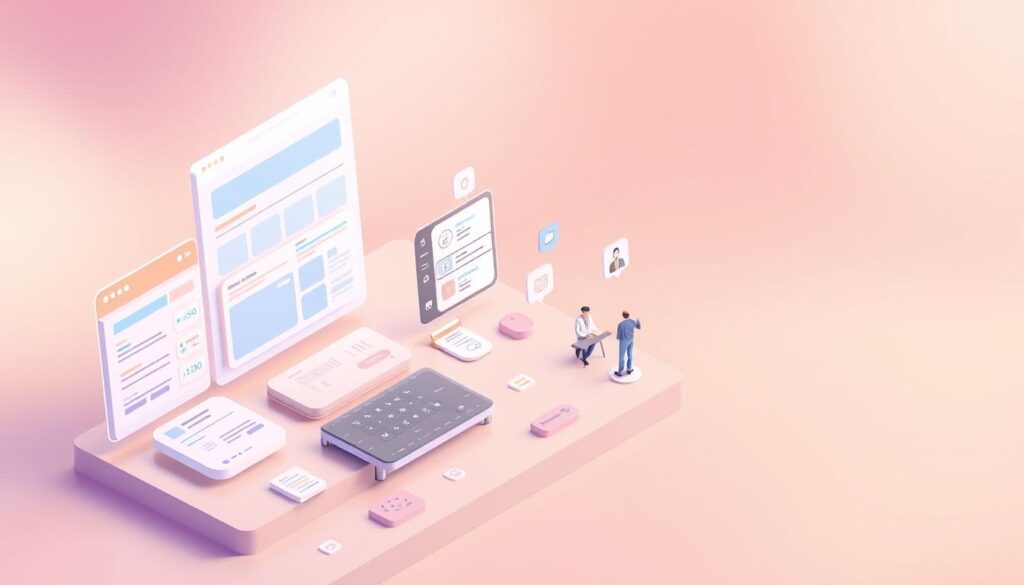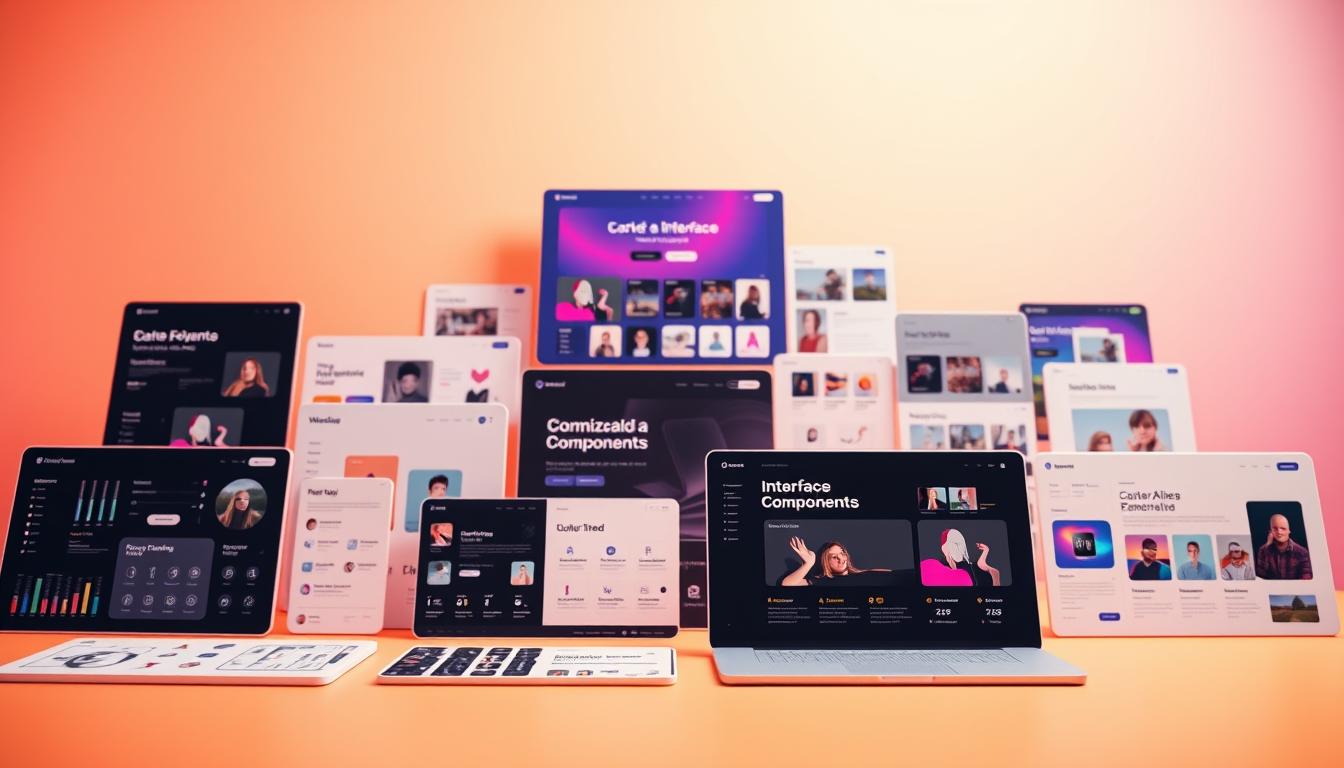Designing a visually appealing and user-friendly interface can be a daunting task, especially for those with limited resources. Streamlining the design process is crucial for designers to meet deadlines and deliver high-quality results.
One effective way to boost productivity is by utilizing pre-designed templates. Pre-made templates can serve as a solid foundation, allowing designers to focus on customization and fine-tuning.
With numerous resources available, finding the right templates can be overwhelming. This comprehensive guide will walk you through the benefits of using templates, where to find them, and how to tailor them to your needs.
Key Takeaways
- Discover the benefits of using pre-designed Figma templates for your projects.
- Learn where to find high-quality, customizable templates.
- Understand how to efficiently customize templates to suit your design needs.
- Explore tips for effectively utilizing templates in your design workflow.
- Enhance your design productivity with the right resources.
Understanding Figma Templates and Their Benefits
By leveraging Figma templates, designers can focus on creating high-quality designs while saving time and resources. Figma templates are pre-designed files that provide a starting point for various design projects.
What Are Figma Templates?
Figma templates are professional Figma resources that include pre-made designs, layouts, and assets. They are designed to be customizable design assets, allowing designers to easily modify and adapt them to their specific needs.
Why Use Templates in Your Design Workflow
Using Figma templates in your design workflow can significantly enhance productivity. Templates help designers:
- Save time by providing a pre-designed foundation
- Maintain consistency across multiple projects
- Focus on high-level creative decisions rather than starting from scratch
Time and Resource Savings for Designers
Figma templates offer substantial time and resource savings for designers. By using pre-designed templates, designers can:
- Reduce the time spent on repetitive design tasks
- Allocate more resources to complex and creative aspects of their projects
- Streamline their design process, leading to faster project completion

The Best Free Figma Templates for Designers
The world of design has been revolutionized by Figma, offering an array of free templates that cater to diverse design needs. Designers can now leverage these resources to create stunning UI/UX designs, mobile app interfaces, website designs, and dashboard/analytics layouts without starting from scratch.
UI/UX Design Templates
UI/UX design templates are crucial for creating user-friendly and aesthetically pleasing interfaces. Top-rated Figma UI kits offer pre-designed components and layouts that can be easily customized to fit specific project requirements. These templates not only save time but also ensure consistency across the design.
Mobile App Interface Templates
For mobile app designers, Figma offers a range of high-quality design templates specifically tailored for mobile app interfaces. These templates include pre-designed screens and components that can be easily adapted to various app designs, streamlining the design process.
Website Design Templates
Website design templates provide a solid foundation for web designers to create visually appealing and functional websites. With Figma’s free templates, designers can quickly prototype and iterate on their designs, ensuring a smooth user experience.
Dashboard and Analytics Templates
Dashboard and analytics templates are essential for designing data-intensive interfaces. Figma’s templates in this category offer pre-designed layouts and components that help designers create informative and intuitive dashboards, making it easier to visualize complex data.
By utilizing these high-quality design templates, designers can significantly enhance their workflow, focusing more on the creative aspects of their projects rather than the initial setup. Whether you’re working on a UI/UX design, mobile app interface, website design, or dashboard/analytics, Figma’s extensive library has got you covered.
“Figma’s template library is a game-changer for designers, providing instant access to professionally designed templates that can be customized to fit any project’s needs.”
Where to Find High-Quality Free Figma Templates
Discovering the right Figma template is simplified by exploring official and community-driven sources. Designers can now access a wide range of high-quality templates without having to start from scratch.
Official Figma Community Resources
Figma’s official community resources are a treasure trove for designers. The Figma Community page hosts a variety of templates shared by the Figma team and its community members. These templates are not only free but also cater to a wide range of design needs, from UI/UX to website design.
Third-Party Design Marketplaces
Several third-party design marketplaces offer free Figma templates. Websites like UI8 and Creative Market occasionally offer free downloads, including Figma templates. These marketplaces are excellent resources for designers looking for high-quality templates.
Designer Portfolios and GitHub Repositories
Many designers share their work, including Figma templates, on their portfolios or on platforms like GitHub. These repositories are often open-source, allowing designers to download, modify, and use the templates for their projects.
Social Media Design Communities
Social media platforms, particularly those focused on design like Dribbble and Behance, are great places to find free Figma templates. Designers often share their templates on these platforms, making it easier for others to discover and download them.
| Resource | Description | Link |
|---|---|---|
| Figma Community | Official Figma community resources | https://www.figma.com/community |
| UI8 | Third-party marketplace with free Figma templates | https://ui8.net/ |
| Dribbble | Social media platform for designers to share templates | https://dribbble.com/ |
How to Evaluate and Choose the Right Template
To ensure your design project gets off to a great start, it’s essential to evaluate Figma templates carefully. With a vast array of templates available, selecting the right one can significantly impact your project’s success.
Assessing Template Quality and Organization
When evaluating a Figma template, the first aspect to consider is its quality and organization. A well-structured template should have:
- Clear and concise layer naming
- Logical grouping of elements
- Consistent design elements throughout
A template that is well-organized not only saves time but also enhances collaboration among team members.
Checking Compatibility with Your Project Needs
It’s crucial to ensure that the template you choose aligns with your project’s specific requirements. Consider the following:
- Does the template match your project’s scale and complexity?
- Are the template’s design elements customizable to fit your brand?
- Does the template support the features you need, such as interactive prototypes?
By answering these questions, you can narrow down your options to templates that are truly suitable for your project.
Understanding License Terms and Attribution Requirements
Before downloading a template, especially from popular Figma template downloads, it’s vital to understand the licensing terms. Some templates may require attribution, while others may have restrictions on commercial use.
Always review the license agreement to avoid any potential legal issues. By doing so, you can ensure that your use of the template is compliant with the creator’s requirements.
Step-by-Step Guide to Customizing Figma Templates
Effective customization of Figma templates requires a step-by-step approach to unlock their full potential. By following a structured process, designers can efficiently tailor templates to their specific needs, saving time and enhancing productivity.
Setting Up Your Workspace
Before diving into customization, it’s essential to set up your workspace correctly. Start by opening the Figma template you’ve chosen and familiarize yourself with the layout. Organize your layers and frames to ensure a smooth design process. Rename layers and groups as needed to maintain clarity.
Modifying Colors, Typography, and Assets
Customizing the visual elements is a crucial step. Begin by modifying the color palette to match your brand’s identity. Adjust typography by selecting fonts, sizes, and line heights that align with your design requirements. Replace or edit existing assets, such as icons and images, to fit your project’s needs.
Adapting Components and Auto Layout
Figma’s component system allows for efficient design updates. Adapt components to your project’s requirements by modifying their properties and styles. Utilize Auto Layout to create responsive designs that adjust seamlessly to different screen sizes and orientations.
Creating Variants and Interactive Prototypes
To add interactivity to your design, create variants of components and use them to demonstrate different states or interactions. Figma’s prototyping features enable you to link frames and create interactive flows, allowing you to test and refine your design.
By following these steps, you can effectively customize Figma templates and leverage their full potential to streamline your design workflow.
Best Practices for Working with Templates in Figma
To maximize the benefits of using free Figma templates, it’s essential to understand the best practices for working with them. By adopting these practices, designers can optimize their workflow, enhance collaboration, and maintain consistency across their designs.
Organizing Your Template Files
Effective organization of your Figma template files is crucial for efficient design work. This involves creating a logical folder structure, using descriptive file names, and maintaining a consistent naming convention. By doing so, you can quickly locate the templates you need and avoid confusion.
Maintaining Design System Consistency
Consistency is key to a cohesive design system. When using Figma templates, ensure that they align with your project’s design principles and guidelines. This includes using consistent typography, color schemes, and component styles. Regularly reviewing and updating your templates helps maintain this consistency.
Collaborating with Team Members
Figma’s collaborative features make it easy to work with team members. When using templates, ensure that all team members are aware of the template structure and guidelines. Use Figma’s commenting and @mention features to facilitate communication and feedback.
Building Your Own Template Library
Creating your own library of templates can significantly boost your productivity. Identify frequently used design elements and patterns, and create templates for them. This not only saves time but also helps in maintaining consistency across different projects.
By implementing these best practices, designers can unlock the full potential of Figma templates and enhance their overall design workflow.
Conclusion
By leveraging free Figma templates, designers can significantly streamline their workflow, focusing on creating high-quality, professional designs. The comprehensive guide provided has equipped designers with the knowledge to find, evaluate, and customize customizable design assets, thereby enhancing their overall design efficiency.
With the ability to access a wide range of templates, designers can now create complex designs with ease, saving time and resources. By applying best practices and utilizing customizable design assets, designers can maintain consistency across their projects and collaborate more effectively with team members.
As designers continue to explore and utilize Figma templates, they will be able to create innovative and engaging designs that meet the needs of their clients. By integrating customizable design assets into their workflow, designers can stay ahead of the curve and deliver high-quality designs efficiently.
